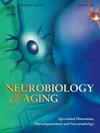年龄和饮食蛋氨酸限制对 rTg4510 小鼠额颞叶痴呆模型认知和行为表型的影响。
IF 3.7
3区 医学
Q2 GERIATRICS & GERONTOLOGY
引用次数: 0
摘要
糖尿病和肥胖等代谢紊乱与神经退行性疾病有关,有证据表明痴呆症患者的脑葡萄糖代谢和胰岛素抵抗较低。膳食蛋氨酸限制(MR)是一种营养干预措施,可增强胰岛素敏感性并延缓衰老相关的代谢改变,但其对神经退行性疾病的影响尚未完全明了。在这里,我们研究了过度表达人类 P301L 突变 tau 的小鼠 tau 病模型(rTg4510)在 6 个月和 12 个月大时的行为和代谢表型,并评估了为期 8 周的饮食 MR 对年长组小鼠的影响。虽然 rTg4510 小鼠在两个年龄段都表现出进行性行为和运动障碍,但 MR 在 12 个月大的小鼠群中产生了显著的益处,改善了运动协调、短期记忆和社会识别能力。这些影响伴随着海马中糖酵解标记物和 FGF21R1 水平的增加,以及葡萄糖代谢/肥胖的改变。总之,我们的研究结果揭示了MR对FTD小鼠模型的影响,表明这是一种潜在的治疗干预措施,可以延缓和/或改善tau相关疾病的进展。本文章由计算机程序翻译,如有差异,请以英文原文为准。
Effects of age and dietary methionine restriction on cognitive and behavioural phenotypes in the rTg4510 mouse model of frontotemporal dementia
Metabolic disorders such as diabetes and obesity are linked to neurodegenerative diseases, with evidence of lower brain glucose metabolism and insulin resistance in dementia patients. Dietary methionine restriction (MR) is a nutritional intervention that enhances insulin sensitivity and delays ageing-associated metabolic alterations, however, its impact on neurodegenerative diseases is not fully understood. Here, we examined the behavioural and metabolic phenotypes of a murine tauopathy model (rTg4510), which overexpresses human P301L mutated tau, at 6 and 12 months of age, assessing the impact of an 8-week dietary MR in the older group. While rTg4510 mice displayed progressive behavioural and motor impairments at both ages, MR led to significant benefits in the 12-month-old cohort, improving motor coordination, short-term memory, and social recognition. These effects were accompanied by increased glycolysis markers and FGF21R1 levels in the hippocampus, alongside unaltered glucose metabolism/adiposity. Overall, our results reveal the impact of MR on an FTD-mouse model, suggesting this as a potential therapeutic intervention to delay and/or improve the progression of tau-related disease.
求助全文
通过发布文献求助,成功后即可免费获取论文全文。
去求助
来源期刊

Neurobiology of Aging
医学-老年医学
CiteScore
8.40
自引率
2.40%
发文量
225
审稿时长
67 days
期刊介绍:
Neurobiology of Aging publishes the results of studies in behavior, biochemistry, cell biology, endocrinology, molecular biology, morphology, neurology, neuropathology, pharmacology, physiology and protein chemistry in which the primary emphasis involves mechanisms of nervous system changes with age or diseases associated with age. Reviews and primary research articles are included, occasionally accompanied by open peer commentary. Letters to the Editor and brief communications are also acceptable. Brief reports of highly time-sensitive material are usually treated as rapid communications in which case editorial review is completed within six weeks and publication scheduled for the next available issue.
 求助内容:
求助内容: 应助结果提醒方式:
应助结果提醒方式:


